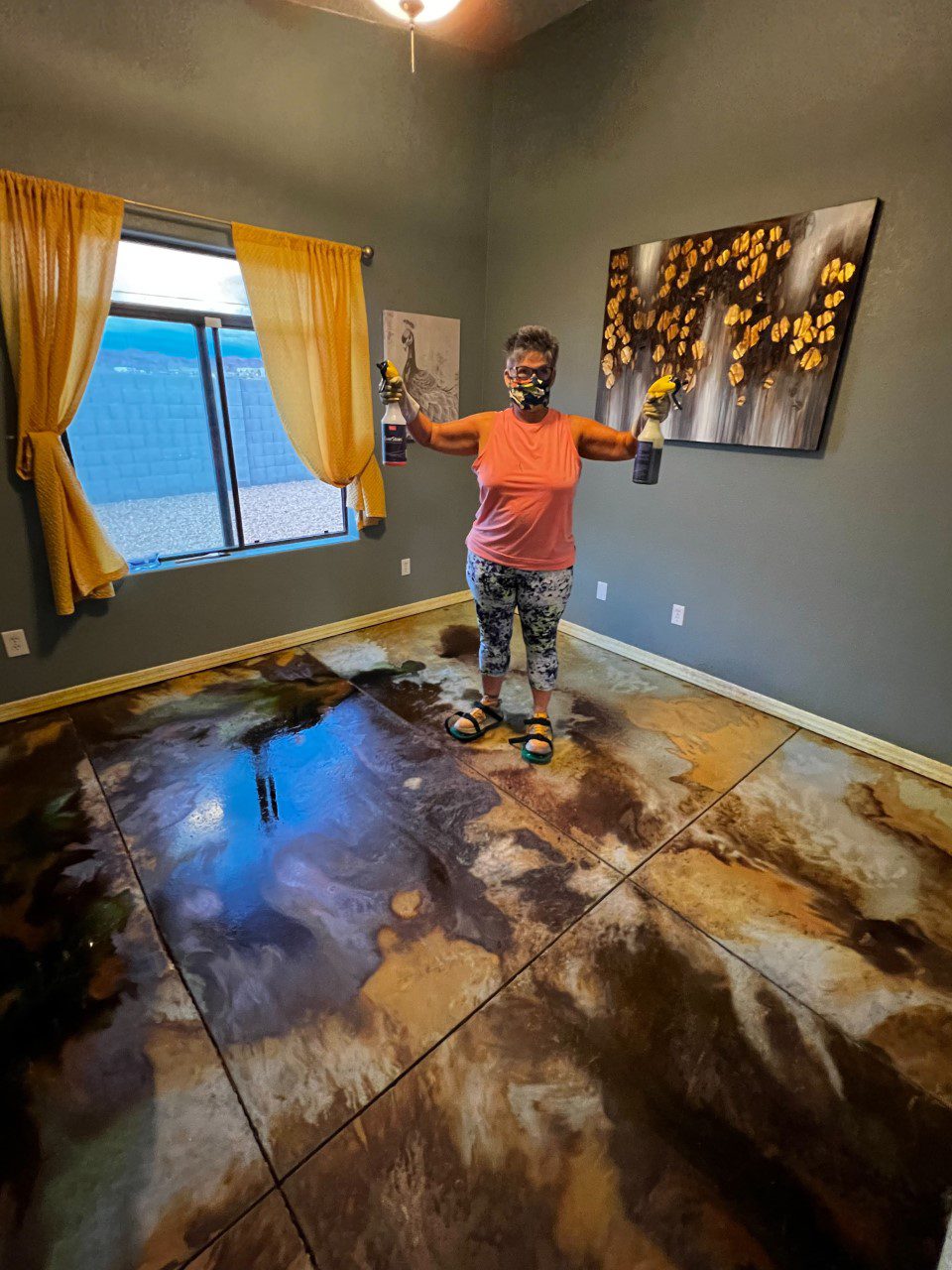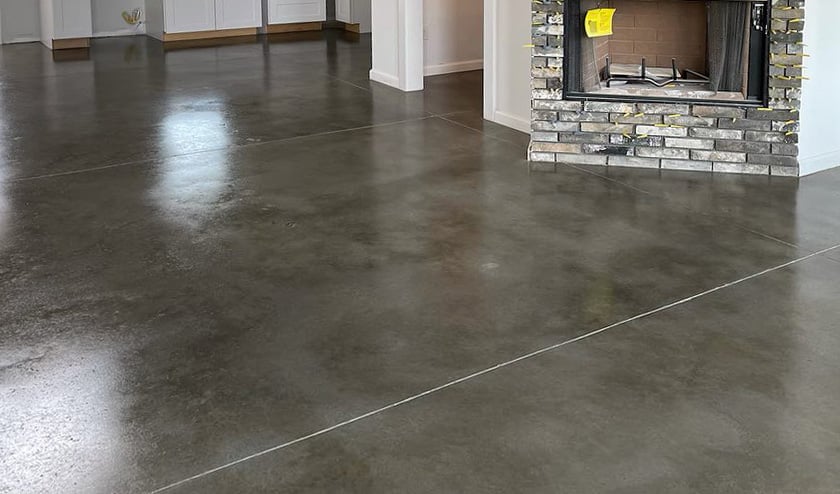Everything About Stained Concrete: A Comprehensive Overview to Its Advantages and Applications
Stained concrete has actually arised as a prominent selection for both domestic and commercial rooms. Its capacity to incorporate aesthetic charm with functionality makes it a fascinating choice. Different staining strategies provide a series of shades and finishes, permitting for customization. The advantages extend past look. Comprehending its applications and upkeep needs is essential for any individual considering this versatile material. The subtleties of stained concrete invite even more exploration.
What Is Stained Concrete?

Staining can be related to numerous surfaces, including floorings, driveways, and patio areas, making it a functional alternative for both interior and outdoor spaces. The therapy can attain a variety of looks, from earthy tones to bold, modern designs. Unlike paint, stained concrete maintains its appearance in time, as it becomes an integral part of the concrete itself. Overall, stained concrete works as an efficient technique for transforming common concrete into visually striking surface areas.
Benefits of Stained Concrete
Stained concrete deals substantial benefits, particularly in visual charm and toughness - stained concrete contractors. Its vivid colors and distinct patterns enhance the aesthetic appeal of any room, making it a prominent choice for both household and industrial applications. Additionally, the long life of stained concrete assurances that it remains a sensible investment over time, standing up to wear and tear
Visual Charm
Among the most engaging advantages of making use of stained concrete is its amazing visual appeal. Stained concrete deals a distinct and versatile appearance that can complement numerous design styles, from modern-day to rustic. The infusion of dynamic shades and elaborate patterns permits property owners and developers to create personalized surface areas that can enhance the general setting of a space. Unlike standard flooring choices, stained concrete can resemble the appearance of natural rock or sleek marble, offering a high end appearance without the associated expenses. Furthermore, the shiny finish choices can show light, more brightening interiors. This versatility makes stained concrete a popular choice for both domestic and business applications, where aesthetic influence is critical.
Resilience and Long life
The excellent visual high qualities of stained concrete are enhanced by its amazing durability and long life - stained concrete. Stained concrete surfaces are resistant to deterioration, making them suitable for high-traffic locations both indoors and outdoors. Their durable nature implies they can hold up against severe weather, including severe temperatures, rainfall, and UV exposure, without substantial deterioration. In enhancement, stained concrete needs very little upkeep contrasted to other floor covering alternatives, as it does not require constant sealing or redecorating. This longevity not just decreases substitute costs but also adds to a lasting structure strategy. Overall, stained concrete provides a long-lasting option that incorporates aesthetic allure with functional benefits, guaranteeing its worth with time
Various Kinds Of Staining Techniques
Different staining techniques can substantially influence the visual high qualities of concrete surfaces. The 3 main techniques consist of acid staining, which responds chemically with the concrete, water-based staining, which supplies a broader series of shades, and overlay staining alternatives that give a fresh surface area. Each method has distinct characteristics and applications that provide to different design preferences and project requirements.
Acid Discoloration Method
How can homeowners transform ordinary concrete surfaces into visually striking attributes? One effective method is acid discoloration, a prominent method that improves the all-natural elegance of concrete. This process includes using a remedy of water, hydrochloric acid, and metal salts to the concrete surface. As the acid responds with the lime present in the concrete, it creates rich, variegated colors that look like marble or rock. Acid staining is recognized for its durability and resistance to fading, making it a lasting option for both interior and outside applications. It is necessary to keep in mind that the outcomes can differ based on the initial concrete shade and structure. Correct application and sealing are vital for attaining the wanted visual and longevity
Water-Based Staining Technique
A popular choice to acid discoloration, the water-based staining technique provides house owners a versatile means to improve concrete surface areas. This technique uses water-soluble dyes and pigments, enabling a variety of shades and finishes. Unlike acid spots, water-based stains can be related to unsealed concrete and provide a less complicated cleanup process. The outcomes can attain a much more uniform appearance and can published here be layered to create distinct impacts. Additionally, water-based spots are generally much less poisonous and discharge fewer unstable organic substances (VOCs), making them much more eco-friendly. House owners might value the capability to tailor their concrete surfaces with different tones, permitting creative expression while maintaining sturdiness and durability in their floor covering options.
Overlay Staining Options
Countless overlay staining alternatives exist for home owners looking to rejuvenate their concrete surfaces. One popular option is acid discoloration, which reacts chemically with the concrete to create abundant, variegated shades. An additional option is water-based staining, using a wider color scheme and simpler application. Furthermore, concrete overlays can be integrated with patterns for complex designs, boosting aesthetics. For an extra distinctive coating, house owners may think about making use of stamped overlays that simulate natural materials like rock or floor tile. Each technique provides unique advantages, from longevity to modification, enabling for a personalized touch. Eventually, the option of overlay discoloration relies on the desired look and the condition of the existing concrete, making sure a rejuvenated and appealing surface.
Applications of Stained Concrete
Stained concrete offers a flexible solution for numerous applications, boosting both visual appeal and functionality. This site here material is typically utilized in property, business, and commercial settings, making it a popular choice among designers and developers. In homes, stained concrete can offer as fashionable floor covering or outdoor patios, providing a sophisticated look while remaining resilient.
In commercial spaces, such as stores and restaurants, stained concrete adds to a modern-day setting and can hold up against hefty foot web traffic. Furthermore, stained concrete is progressively utilized in public spaces like parks and sidewalks, where its capacity to simulate natural stone or other products includes visual interest.
Furthermore, stained concrete is ideal for swimming pool decks and driveways, supplying a slip-resistant surface area that is easy to keep. Overall, the flexibility of stained concrete makes it ideal for many environments, providing to varied tastes and needs.
Upkeep and Look After Stained Concrete
Appropriate maintenance ensures the longevity and appeal of stained concrete surfaces. Normal cleaning is crucial; utilizing a mild detergent and water with a soft-bristle brush aids remove dirt and crud without damaging the surface. It is advisable to prevent rough chemicals that can remove the tarnish or sealer.
Securing stained concrete is vital for defense against moisture, stains, and use. A high-quality sealant needs to be reapplied each to three years, relying on the traffic and direct exposure the surface endures. In addition, dealing with spills immediately will avoid discoloration and discoloration.

Cost Factors To Consider for Stained Concrete Projects
When preparing a tarnished concrete job, spending plan considerations play an essential duty in determining the general price. The expenses related to stained concrete can vary significantly based upon a number of variables. The dimension of the location to be stained directly influences product and labor prices. Larger areas will normally need more sources. Second, the type of tarnish picked-- acid-based or water-based-- can impact pricing, with acid stains often being extra expensive. Furthermore, the intricacy of the layout, consisting of patterns or multiple colors, can boost labor prices. Preparation work, such as cleaning and grinding the concrete surface, includes to the first expenditures as well. Ultimately, the selection in between DIY installation and hiring an expert contractor will additionally affect the spending plan. Understanding these factors enables homeowners to make informed financial choices about their stained concrete projects, guaranteeing they achieve the preferred visual within their monetary ways.
Tips for Selecting the Right Stained Concrete for Your Space
Selecting the best stained concrete for a particular space entails mindful consideration of different elements beyond simply budget plan. One should review the desired use of the area. High-traffic areas might require even more sturdy surfaces, while attractive applications can focus on appearances.
The shade combination is another vital facet; the selected hues should integrate with existing style and illumination. It's likewise essential to think about the surface area texture, as smooth coatings can improve sophistication, while distinctive options might ensure safety in damp locations.
Regional climate and ecological problems play a considerable role in the durability and maintenance of stained concrete, affecting the choice of sealers and coatings.
Lastly, talking to experts can offer important understandings customized to details requirements, ensuring the choice of the suitable stained concrete that lines up with both capability and style.

Often Asked Concerns
Can Stained Concrete Be Applied Over Existing Flooring?
Stained concrete can without a doubt be applied over existing flooring, gave the surface area is stable and adequately prepared. This approach enables for an aesthetic upgrade without the demand for complete elimination of the original floor covering products.
The Length Of Time Does Stained Concrete Last?
Stained concrete can last for decades when properly preserved. Factors such as website traffic, environmental problems, and application methods greatly affect its longevity, with many installments remaining vivid and intact for 10 to three decades.
Is Stained Concrete Slippery When Wet?
Stained concrete can be unsafe when wet, as the surface may produce a smooth surface area. Utilizing non-slip ingredients or textured surfaces can minimize this issue, improving safety and security without compromising the visual allure of the concrete.
Can I Stain Concrete Myself, or Should I Employ a Specialist?
The choice to stain concrete directly or employ a specialist joints on ability level and project complexity. While DIY staining can save cash, professionals guarantee suitable outcomes, especially for elaborate layouts or huge surfaces.
What Colors Are Offered for Stained Concrete?
The range of shades readily available for stained concrete includes earthy tones like browns and tans, lively tones such as reds and blues, and softer hues like pastels. This palette enables innovative, tailored design alternatives.